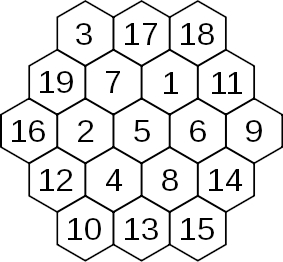
French conceptual artist Julien Berthier designed this yacht, known as the Love Love — it’s fully seaworthy but appears perpetually to be sinking.
He says it represents “lost hope and death.”
(Via the American Sailing Association.)

French conceptual artist Julien Berthier designed this yacht, known as the Love Love — it’s fully seaworthy but appears perpetually to be sinking.
He says it represents “lost hope and death.”
(Via the American Sailing Association.)

There’s only one normal magic hexagon — only one hexagonal arrangement of cells like the one shown here that can be filled with the consecutive integers 1 to n such that every row, in all three directions, sums to the same total. (This excludes the trivial example of a single cell on its own, as well as rotations and reflections of the hexagon shown here.)
Amazingly, it appears that this lonely example may not have been discovered until 1888! In a 1988 letter to the Mathematical Gazette, Martin Gardner reported that the magic hexagon was given as a problem in the German magazine Zeitschrift für mathematischen und naturwissenschaftlichen Unterricht (Volume 19, page 429) in 1888. The proposer was identified only as von Haselberg, of Stralsund; his solution was published in the next volume.
Gardner writes, “The structure could easily have been discovered by mathematicians in ancient times, but as of now, this is the earliest known publication.”
(Martin Gardner, “The History of the Magic Hexagon,” Mathematical Gazette 72:460 [June 1988], 133.)

Riverside, Iowa, claims Star Trek‘s James T. Kirk as a future native. In a 1968 book, series creator Gene Roddenberry had written that Kirk was born in Iowa; in 1985 city council member Steve Miller proposed that this will happen in Riverside, and the motion passed unanimously.
Two Star Trek novels have taken up the conceit, though it’s not considered canon. I guess we’ll see what happens — he’s due to arrive (somewhere!) on March 22, 2228.
In Ulysses, Leopold Bloom’s locked private drawer at 7 Eccles Street contains, among other things:
3 typewritten letters, addressee, Henry Flower, c/o P.O. Westland Row, addresser, Martha Clifford, c/o P.O. Dolphin’s Barn: the transliterated name and address of the addresser of the 3 letters in reversed alphabetic boustrophedontic punctated quadrilinear cryptogram (vowels suppressed) N. IGS./WI. UU. OX/W. OKS. MH/Y. IM …
This actually works: Quadrilinear means that the cipher is to be set in four lines; reversed alphabetic means that the key is a = z, b = y, etc.; and boustrophedontic is a term from paleography meaning that the writing runs right and left in alternate lines. So the cryptogram and its solution look like this:
N . I G S . m a r t h a W I . U U . O X d r o f f i l c W . O K S . M H d o l p h i n s Y . I M b a r n
Apparently Joyce or Bloom forgot that the last line should run right to left.
(From David Kahn, The Codebreakers, 1967.)

The Airavatesvara Temple of Tamil Nadu bears a remarkable ambiguous carving — the head can be perceived as belonging either to the bull or to the elephant.

“When we go up to the shelves in the reading-room of the British Museum, how like it is to wasps flying up and down an apricot tree that is trained against a wall, or cattle coming down to drink at a pool!” — Samuel Butler, Notebooks, 1912
In a 1951 article in the New York Times Magazine, Bertrand Russell laid out “the Ten Commandments that, as a teacher, I should wish to promulgate”:
“The essence of the liberal outlook in the intellectual sphere is a belief that unbiased discussion is a useful thing and that men should be free to question anything if they can support their questioning by solid arguments,” he wrote. “The opposite view, which is maintained by those who cannot be called liberals, is that the truth is already known, and that to question it is necessarily subversive.”

History’s ancient example of camouflage, the Trojan Horse, has a modern variation of peculiar interest. During the fighting near Craonne on the western front, some time ago, a horse broke his traces and dashed across ‘No Man’s Land’ toward the German defenses. When near the edge of a first-line trench he fell. The French immediately made the best of the opportunity and set camouflage artists at work fashioning a papier-mâché replica of the dead animal. Under cover of darkness the carcass was replaced with the dummy. For three days observers stationed in the latter were able to watch the enemy’s movements at close range and telephone their information to headquarters. Finally, when one observer was relieving another, the Germans discovered they had been tricked, and destroyed the post.
— “Observer Hides in Dummy Horse Near Enemy Trench,” Popular Mechanics 29:1 (January 1918), 72.
On another occasion, a standing tree, whose branches had all been shot away, was carefully photographed and an exact copy of it made, but with a space inside in which an observer could be concealed. One night, while the noise of the workmen was drowned by heavy cannonading, this tree was replaced by its facsimile. And there it remained for many a day before the enemy discovered that it was a fake tree-trunk. It provided a tall observation-post from which an observer could direct the fire of his own artillery.
— A. Russell Bond, “Warriors of the Paint-Brush,” St. Nicholas 46:6 (April 1919), 499-505.
SEVEN PLUS TWO = EIGHTEEN MINUS NINE = EIGHTEEN OVER TWO
That’s true enough on its face. But Susan Thorpe discovered that if each letter is replaced with the number of its position in the alphabet (A=1, B=2, etc.), then the equivalence persists — the values in each of the three phrases total 191.
(Susan Thorpe, “Number Name Equations,” Word Ways 30:1 [February 1997], 34-36.)
10/25/2020 UPDATE: Reader Jacob Bandes-Storch has found many more of these:
SIX OVER TWO PLUS TEN (277)
= FOUR MINUS ONE PLUS TEN (277)
= EIGHT OVER TWO PLUS NINE (277)
= ONE PLUS FIVE PLUS SEVEN (277)
= TWENTY SIX OVER TWO (277)
ONE PLUS ONE PLUS TWELVE (291)
= ONE PLUS TWO PLUS ELEVEN (291)
= TWO PLUS TWO PLUS TEN (291)
= FIFTEEN OVER THREE PLUS NINE (291)
= EIGHT MINUS THREE PLUS NINE (291)
FIFTEEN OVER THREE PLUS ELEVEN (312)
= EIGHT MINUS THREE PLUS ELEVEN (312)
= TWELVE OVER TWO PLUS TEN (312)
= ELEVEN MINUS THREE PLUS EIGHT (312)
FIFTEEN PLUS FORTY THREE = TWENTY NINE TIMES TWO = SEVENTY MINUS TWELVE (273)
THIRTEEN PLUS FIFTY SIX = TWENTY THREE TIMES THREE = EIGHTY EIGHT MINUS NINETEEN (285)
NINETEEN PLUS FIFTY THREE = THIRTY SIX TIMES TWO = SEVENTY THREE MINUS ONE (276)
TWO PLUS SEVENTY THREE = ONE HUNDRED FIFTY OVER TWO = NINETY THREE MINUS EIGHTEEN (292)
SEVENTEEN PLUS FIFTY EIGHT = ONE HUNDRED FIFTY OVER TWO = NINETY THREE MINUS EIGHTEEN (292)
FORTY PLUS FORTY FIVE = TWENTY EIGHT TIMES THREE = NINETY SIX MINUS ELEVEN (278)
TWO PLUS NINETY SEVEN = THIRTY THREE TIMES THREE = ONE HUNDRED FIVE MINUS SIX (also 278)
He says he hasn’t found any quadruplets where each phrase uses a single function and all are different, but this may yet be possible. (Thanks, Jacob.)

In 1829 a group of convicts commandeered a brig in Tasmania and set off across the Pacific, hoping to elude their pursuers and win their freedom. In this week’s episode of the Futility Closet podcast we’ll describe the mutineers of the Cyprus and a striking new perspective on their adventure.
We’ll also consider a Flemish dog and puzzle over a multiplied Oscar.